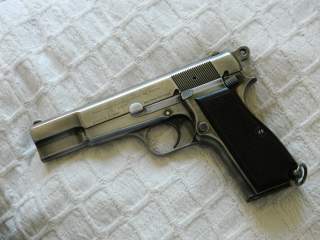This Gun in Almost 90 Years Old (But Might Be Just as Good as a Glock or Sig Sauer)
What could it be?
The Hi Power’s design, although ninety years old, is similar to the so-called “Wonder Nines” of the early 1980s. A simple to disassemble, reliable semi automatic pistol with a large capacity nine millimeter magazine, the Hi Power is similar to the Sig Sauer P226, Glock 17, Beretta 92 and the Smith & Wesson Model 59. The Hi Power is still sold today, although ironically it costs considerably more than the generation of handguns it influenced. John Moses Browning’s final handgun was decades ahead of its time.
One of the longest-serving handguns of all time was the final work of the most prolific gun designer of all time. The Browning Hi Power pistol was the last handgun designed by John Moses Browning, American weapon designer extraordinaire, whose inventions are still popular more than ninety years after his death. The Hi Power was arguably the first of the “Wonder Nines”—simple, accurate nine millimeter handguns with large capacity magazines that dominate the handgun market today.
The son of a Mormon pioneer, John Moses Browning learned the craft of gunsmithing in his father’s gun shop. Browning built his first firearm in 1868 at the age of 13, the first of a long line of handguns, long guns and machine guns. Browning designed more than thirty firearms, with the Winchester 1885 single shot rifle, Remington Model 8, Browning Auto 5, Colt Woodsman, Colt 1903, Colt 1911, Browning Automatic Rifle (BAR) and M2 Heavy Machine Gun. The latter is still in use by the U.S. military to this day. Browning also invented a number of gun calibers, including the .380 ACP, .45 ACP, and .50 BMG.
Although Browning is today best known for the Colt 1911A1 handgun and the M2 “Ma Deuce” heavy machine gun, his final pistol design was decades ahead of the competition. The Browning Hi Power handgun was designed by Browning in the late 1920s in response to a competition for the new French Army pistol, which was dubbed the Grande Puissance ("high power") 35. Browning was commissioned by Belgian arms manufacturer Fabrique Nationale d’Armes de Guerre—FN for short—to design a new pistol. That pistol would later be known as the Hi Power (HP) or GP35 for short.
Recommended: Uzi: The Israeli Machine Gun That Conquered the World
Recommended: The M4: The Gun U.S. Army Loves to Go to War With
Recommended: Why Glock Dominates the Handgun Market (And Better than Sig Sauer and Beretta)
The GP35 was without the technical benefit of Browning’s intellectual property in the 1911A1, whose rights had been sold to Colt. Instead of the hinged link which effects barrel/slide recoil on the 1911A1, the GP35 used a shaped cam on the underside of the barrel to do the same job. Field stripping was markedly easier than the 1911A1, nearly on par with today’s simple to disassemble Glocks and Sig Sauers. The handgun was designed to accept an optional wooden carbine stock and had an unusually large (for its time) magazine of 13 rounds, something that keeps the GP35 competitive with the handguns of today.
The GP35 was adopted by the Belgian Army and a handful of smaller armies, including the Lithuanian army. But upon Belgium’s defeat in World War II the plans for the handgun were spirited out of the country. The machinery and tooling to produce the handguns was started up again and the GP35 was one of several handguns carried by German troops, in particular the SS and German fallschirmjäger parachute units. The plans for the GP35 were used by Canadian manufacturer Inglis to produce guns for Nationalist China, and later Canadian and British paratroopers and special forces.
After the war the GP35 was more commonly known as the Hi Power, and the design’s popularity exploded off the charts. It was, by far, the most common handgun of the postwar era until the end of the Cold War. Over ninety countries, from Argentina to Zimbabwe purchased, licensed or imitated Browning’s handgun as a military or police issue weapon. It was a common sidearm in NATO during the Cold War, and was even entered in the 1979 competition to replace the Colt M1911A1 in U.S. military service—another John Browning design. It was carried by Israeli paratroopers on the raid on Entebbe, the Kuwaiti Army during the 1990 invasion of Kuwait and Rhodesian troops fighting ZANLA and ZIPRA guerrillas during the 1970s. The Hi Power was carried by both sides in the 1982 Falklands War, by British and Argentine troops alike.
The Hi Power’s design, although ninety years old, is similar to the so-called “Wonder Nines” of the early 1980s. A simple to disassemble, reliable semi automatic pistol with a large capacity nine millimeter magazine, the Hi Power is similar to the Sig Sauer P226, Glock 17, Beretta 92 and the Smith & Wesson Model 59. The Hi Power is still sold today, although ironically it costs considerably more than the generation of handguns it influenced. John Moses Browning’s final handgun was decades ahead of its time.
Kyle Mizokami is a defense and national-security writer based in San Francisco who has appeared in the Diplomat, Foreign Policy, War is Boring and the Daily Beast. In 2009, he cofounded the defense and security blog Japan Security Watch. You can follow him on Twitter: @KyleMizokami.
This first appeared last year.

